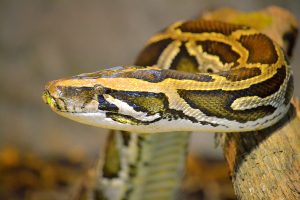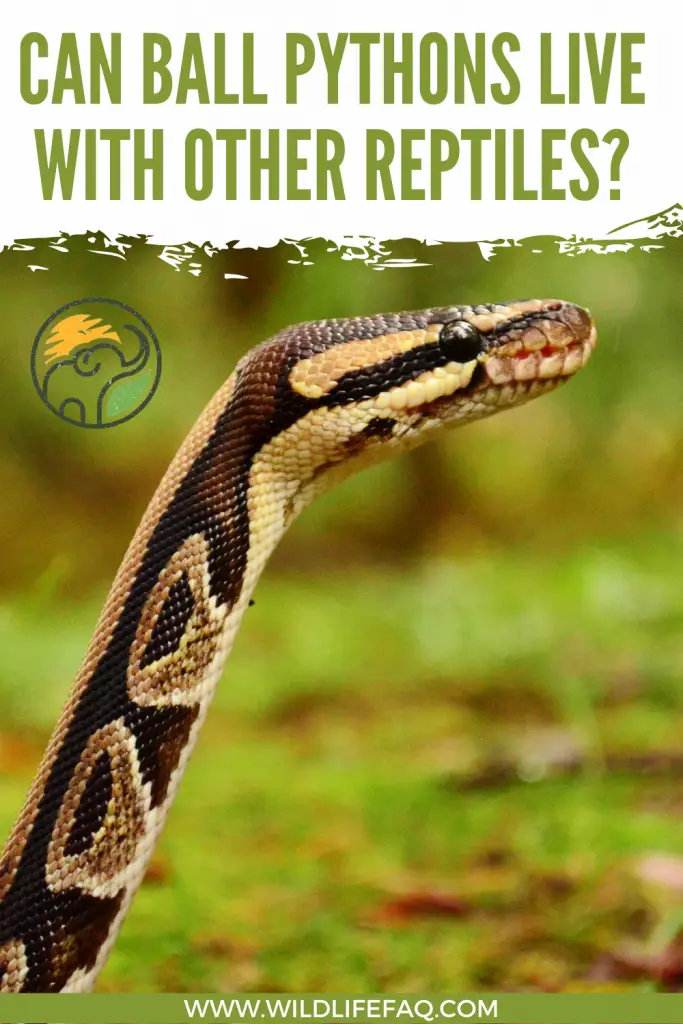Yes, in theory they can but it is not recommended. One reason is that it requires a lot of space for both animals to feel safe.
Ball Pythons (Python regius) are an extremely popular pet choice in many regions of the world. Ball pythons are primarily found within the West and Central Africa, typically under logs or tree branches that they can freely move in and out of at their leisure.
Ball Pythons have stout bodies with an approximately 2-5 feet average length (with females being the biggest), a wide head that is usually dark brown or black in coloration. It is also noted that these snakes are nocturnal.

Ball pythons are commonly kept as pets, with millions of ball pythons owned throughout the world. They generally live an average of 10-15 years though this range is wide due to different living conditions and the animal’s individual health and genetic makeup.
In captivity, they can thrive in a multitude of environments but are most popular in terrariums that simulate their natural habitat well.
This article will delve deep into what it takes for a ball python to coexist with other animals.
Can Ball Pythons Live With Other Reptiles?
Yes. It is possible for ball pythons to live with other reptiles, though the type of reptile they can live with will vary greatly depending on their size and temperament.
Ball pythons are known to be especially good at coexisting with turtles and tortoises so long as they have the required space allotted to them. Other types of reptiles that are relatively small can be kept together with ball pythons but only if it is done properly.
Do ball pythons eat other reptiles?
Ball pythons feed exclusively on rodents and other mammals, not reptiles. They use their intelligence and camouflage to sneak up on their food and then swallow it whole.
The ball python is known to be an opportunistic predator in the wild as well, so if you are breeding ball pythons then it is best that they are fed mice babies from a young age. The snake will digest their food, then use the bones to make their nest, like they would if they were in the wild.
Can a Ball Python Live With Another Animal?
It is not recommended to keep ball pythons living with other animals, regardless of whether or not they are the same species. But it can be done.
This is mainly because it will be nearly impossible to provide the enclosure needed for them. They also have the potential to coexist peacefully through this setup should only occur if you are a professional and know what you are doing. Ball pythons live in heavily wooded areas so animal companionship is not an essential part of their life in captivity.
Can a Ball Python Live With a Tortoise?
It is possible to keep a ball python with turtles and tortoises in the same housing so long as it is done properly. This means a lot of room and space. So not recommended for a private home.
Turtles and tortoises are a great safer option for ball pythons if you have the money to invest in the setup. These reptiles are generally more docile than an average snake so they will be less likely to cause ball pythons harm.
Having a tank large enough that can provide plenty of living space is important when keeping turtles and tortoises with ball pythons. It is also recommended to keep them in different enclosures as this will provide added safety.
Can 2 Snakes Live Together?
Yes. Though it is not the best choice for a snake to live together, it is far from impossible. I have personally done this but it requires a lot of attention especially during feeding so they don’t accidentally bite each other.
Ball pythons generally do not bite each other and are known for being peaceful animals so long as they have proper living conditions. Keep in mind that ball pythons are not venomous snakes, so they will not be setting traps to catch the other animal if they come across it.
Will a Ball Python Eat a Bearded Dragon?
No. It is very unlikely for a ball python to even attempt to try and eat another reptile, let alone an animal as large as a bearded dragon. But it could still attack the dragon if it felt threaten.
The only way that this would even be remotely possible is if the ball python was being starved and had little energy in it. In this case, the snake will most likely attack other animals out of its own desperation to get food in its stomach.
Are Bearded Dragons a Common Allergen for Humans?
Bearded dragons are fascinating reptiles known for their unique appearance and docile nature. However, some individuals may experience allergic reactions to bearded dragons. These reactions may manifest as skin irritation, respiratory issues, or watery eyes. It is essential to consult a healthcare professional if you suspect an allergic response to these enchanting creatures.
Can Ball Pythons Pose a Threat to Humans if Kept with Other Reptiles?
Ball pythons, while not considered snakes capable of eating humans, should still be carefully monitored when housed with other reptiles. Although they are generally docile, conflicts can arise in shared habitats, leading to injury. Proper supervision and handling can help minimize the risk of any potential threats.
Conclusion
Overall, it is extremely possible for ball pythons to live with other reptiles but they will require an enclosure that is incredibly large in size. Larger reptiles need more living space than smaller ones and are also less likely to cause harm.
However, it is important to note that there are some bigger reptiles like bearded dragons that should not be housed with ball pythons because of the potential harm that can come from the interaction.








